Klyde Warren Park: Five Acres of Waterproofing
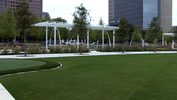
In October 2010, Chamberlin embarked on a project that would mark a time of change for the City of Dallas and its residents. Woodall Rogers Freeway is a major highway that runs just north of Downtown Dallas directly through the city. It is a connector freeway between two other large highways. When Woodall Rogers Freeway was constructed in 1962, highways were the most popular mode of transportation. City officials and wealthy landowners were building homes and purchasing land outside of the Dallas city limits, thus making highways extremely appealing.
In 2000, Dallas’ population reached over two million people, and the highway infrastructure was no longer the most optimal means of transportation. Downtown and uptown were two of the most popular areas for nightlife, business, and residential growth, and there was only one thing standing between them: Woodall Rogers Freeway. During the next 12 years, the City of Dallas began a slow and steady movement geared toward improving mobility.
In 2002, the Dallas Real Estate Council funded a $1 million grant to assess the feasibility of co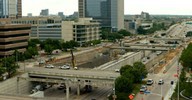 nnecting uptown and downtown by building a park deck over Woodall Rogers Freeway. Allowing residents to have access to the entire city by means of biking, walking, and trolley would increase real estate growth, development and the revitalization of unused areas of the city. By 2004 the Woodall Rogers Park Foundation had formed and the idea of the park was growing in popularity. It would be a project that would change the face of Dallas for years to come.
nnecting uptown and downtown by building a park deck over Woodall Rogers Freeway. Allowing residents to have access to the entire city by means of biking, walking, and trolley would increase real estate growth, development and the revitalization of unused areas of the city. By 2004 the Woodall Rogers Park Foundation had formed and the idea of the park was growing in popularity. It would be a project that would change the face of Dallas for years to come. 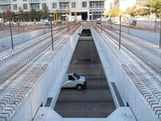
Once city officials approved the concept to build the park deck, Chamberlin met with the architects and design engineers to provide input on how to properly and permanently waterproof the park. The park would be even with street level and still allow Woodall Rogers Freeway to flow freely via tunnel under the deck. The $110 million project was one that Chamberlin felt passionate about being a part of while working extensively with the design team to provide insight on the required waterproofing.
Th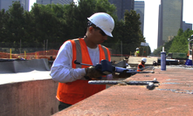 e park deck covers an area of approximately three acres and uses five and one-half acres of waterproofing materials. The massive size of the project required Chamberlin to provide value-engineering services to the general contractor, Archer Western, to stay within the project’s timeline and budget. Chamberlin consulted with the materials manufacturer to design a waterproofing system that was cost-efficient, durable and warrantable. For the next 18 months, Chamberlin’s 22-person crew, supervised by Operations Manager, Andy Wharton and Superintendent, Pete Klein, installed hot fluid-applied waterproofing, root barrier and drainage board over the three acre park deck.
e park deck covers an area of approximately three acres and uses five and one-half acres of waterproofing materials. The massive size of the project required Chamberlin to provide value-engineering services to the general contractor, Archer Western, to stay within the project’s timeline and budget. Chamberlin consulted with the materials manufacturer to design a waterproofing system that was cost-efficient, durable and warrantable. For the next 18 months, Chamberlin’s 22-person crew, supervised by Operations Manager, Andy Wharton and Superintendent, Pete Klein, installed hot fluid-applied waterproofing, root barrier and drainage board over the three acre park deck.
The project was particularly challenging because trenches wer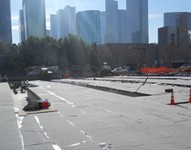 e built into the design of the deck. Each concrete panel joint was detailed with a piece of six inch membrane embedded in hot fluid-applied waterproofing asphalt. Applying 400 degree hot fluid waterproofing material onto a vertical trench requires safe practices and a high level of skill. Once all joint detailing was complete, a primer was applied to the deck in preparation for two layers of hot fluid-applied waterproofing membrane and the cap sheet.
e built into the design of the deck. Each concrete panel joint was detailed with a piece of six inch membrane embedded in hot fluid-applied waterproofing asphalt. Applying 400 degree hot fluid waterproofing material onto a vertical trench requires safe practices and a high level of skill. Once all joint detailing was complete, a primer was applied to the deck in preparation for two layers of hot fluid-applied waterproofing membrane and the cap sheet.
While safety is always a top priority at Chamberlin, extra measures were taken to ensure th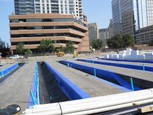 at no workers were burned during the installation of the hot fluid-applied waterproofing. Chamberlin’s Safety Director, Jeremy Waldorf, was on site to enforce the use of proper personal protective equipment (PPE), such as long sleeve shirts, tall leather gloves, safety glasses and vests, hard hats, and fire extinguishers. Chamberlin’s crew kept safety a top priority through the duration of the project.
at no workers were burned during the installation of the hot fluid-applied waterproofing. Chamberlin’s Safety Director, Jeremy Waldorf, was on site to enforce the use of proper personal protective equipment (PPE), such as long sleeve shirts, tall leather gloves, safety glasses and vests, hard hats, and fire extinguishers. Chamberlin’s crew kept safety a top priority through the duration of the project.
In February 2012, Chamberlin’s waterproofing was completed and the landscapi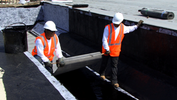 ng and structures of the park were installed. The park was named Klyde Warren Park, after the 10-year-old son of philanthropist, Kelcy Warren, and officially opened to the public on October 27, 2012. Klyde Warren Park is already a key component to the City of Dallas’ growth and development, and Chamberlin is proud to have played a key role in redefining the infrastructure of Dallas.
ng and structures of the park were installed. The park was named Klyde Warren Park, after the 10-year-old son of philanthropist, Kelcy Warren, and officially opened to the public on October 27, 2012. Klyde Warren Park is already a key component to the City of Dallas’ growth and development, and Chamberlin is proud to have played a key role in redefining the infrastructure of Dallas.
Refer to the link below (page 86-90) to view an article mentioned in Coatings Pro Magazine.
http://coatingspromag.epubxp.com/i/235725
Subscribe Today!
Stay-in-the-know and subscribe to our blog today!